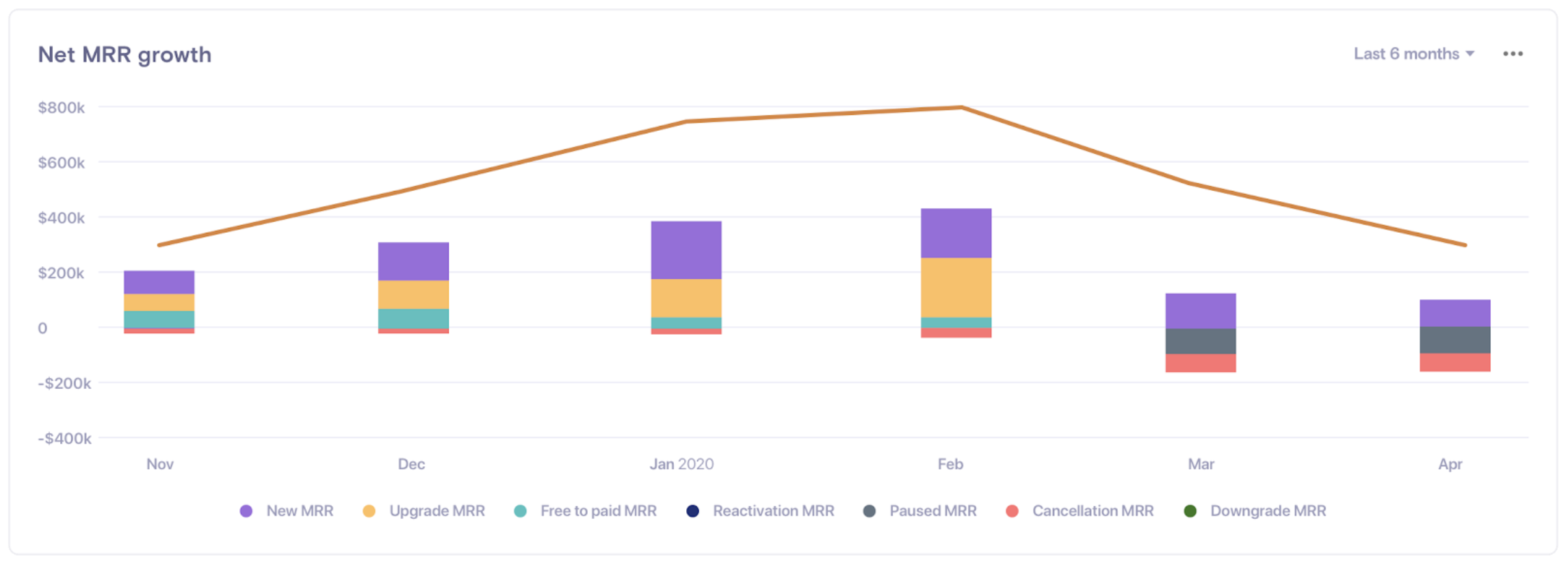PRODUCT
SOLUTIONS
- BY INDUSTRY
- B2B SaaS
- eCommerce
- E-learning
- Publishing
- BY BUSINESS SIZE
- Startup
- ScaleUp
- Enterprise
- BY BUSINESS MODEL
- Self-serve
- Sales-driven
CHARGEBEE RETENTION
Revenue
What is Net MRR Growth Rate?
Your monthly recurring revenue changes month-on-month because of new revenue earned and lost revenue due to churn. Net MRR Growth Rate is an important metric that helps you keep track of these variations.
Why is Net MRR Growth Rate important?
Net MRR Growth considers new revenue, expansions, and contractions (downgrading and cancellations). There are three key factors to ensure overall profitability — minimize MRR churn rate, drive upgrades from existing customers, and add new paying customers. Net MRR Growth shows you how fast your SaaS business is growing.
Quick Ratio and NRR tend to flatten out minor, recent variances in data. The net MRR growth rate allows you to look out for any changes in recent trends.

For example, notice that the Net MRR trend allows you to spot the shrinking new MRR or an uptick in cancellations or paused MRR.
How to calculate Net MRR Growth Rate?
Net MRR = (New MRR + Reactivation MRR + Upgrade MRR) - (Cancellation MRR + Downgrade MRR)
Net MRR Growth Rate = ((Net MRR of Current Month - Net MRR of Last Month) / Net MRR of Last Month)*100
Where,
New MRR is the additional monthly recurring revenue earned from new subscriptions acquired during a month.
Reactivation MRR is the monthly revenue earned from previously churned or canceled subscriptions that are reactivated during the month.
Upgrade MRR is the monthly recurring revenue generated when subscriptions are moved from existing plans to higher plans.
Contraction MRR is the total reduction in MRR due to downgrades and subscription cancellations (or churn) compared to the previous month.
For month-on-month growth, you can calculate this every month and compare with the previous month. To see a trend, calculate it for a longer period (12-16 months).
For example,
Let’s assume that your net MRR for January is $1000. In the month of February, there was $800 of new MRR addition, $400 added from existing subscription upgrades, and $100 of reactivation MRR. However, there was $200 of customer churn.
So your net MRR for February = (800+400+100)-200 = $1100
Net MRR Growth Rate = ((1100-1000)/1000)*100 = 10%
Industry benchmarks for Net MRR Growth Rate
While there are no definitive benchmarks for the net MRR growth rate, there are some guidelines that SaaS businesses in different stages of growth can keep in mind. Let’s take a look at what these experts have to say:
Tomasz Tunguz (Venture Capitalist, Redpoint) says that an MRR growth rate of 15-20% is a reasonably good target for post-Seed/pre-Series A SaaS startups to aim for.
According to Jason Lemkin (Founder, SaaStr), SaaS companies should have the potential to go from $1m- $100m in ARR in 7-10 years. He goes on to say >=20% growth MoM is an outlier, but possible. Most SaaS companies fall under 10-15%.
Pros and Cons of Net MRR Growth Rate

How to increase your Net MRR Growth Rate
An obvious way to boost your net MRR growth rate is to increase the number of customers (duh!). But other than that, you can do these things to increase your MRR growth rate:
Focus on increasing the expansion MRR
Expansion Monthly Recurring Revenue (Expansion MRR) is the additional monthly recurring revenue generated month-on-month from your existing customers. It doesn’t include new MRR acquired from your new customers.
An increase in the expansion revenue contributes to MRR growth with very little added cost. You can increase your expansion MRR by the means of:
Upsells - upselling is when customers move from a free plan to a priced plan or moving from a lower-priced plan to a higher-priced plan.
Cross-sells - cross-selling means the purchase of other additional non-core products offered by you.
Add-ons - purchasing of other recurring add-ons that are not part of the customer’s current subscription plan.
Reactivation - Reactivating a canceled subscription.
Lower your churn rate
Churn rate is the rate at which your customers are canceling their subscriptions.
When your customer acquisition strategy is complemented with an effective churn mitigation strategy, boosting your MRR becomes achievable.
Begin with understanding where your churn is coming from. There are two types of customer churn.
Voluntary churn occurs when customers:
Pause the subscription.
Downgrade to a lower plan.
Cancel the subscription.
When high-value customers try to cancel/downgrade/pause, it’s important to earn their trust and do all you can to make them stay on for longer. You might want to understand the reason behind the churn, such as price sensitivity or value expectation, and reassess your pricing & packaging structures. For example, you can try opening up a few premium features for them or upgrading them to a higher plan for free for the first 6 months.
On the other hand, you have involuntary churn. This occurs when customers are churning due to payment failures and card declines. It’s important to have dunning mechanisms and smart retries in place to mitigate that.
Experiment with your value proposition
The perceived value of your product and your pricing should go hand in hand. To boost your MRR growth, you can experiment with your packaging and pricing to find the sweet spot that works best for your customers.
Conclusion
To summarize, the net MRR growth rate is an important metric to track the growth of your SaaS company. It depends on the new MRR, expansion MRR, and contraction MRR. A Net MRR growth rate of 10-20% is said to be good by the industry experts. To boost your MRR:
Acquire new customers
Reduce churn
Increase upgrades, upsells, cross-sells, etc
Experiment with pricing and packaging
Other relevant SaaS metrics and KPIs
Annual Recurring Revenue (ARR)